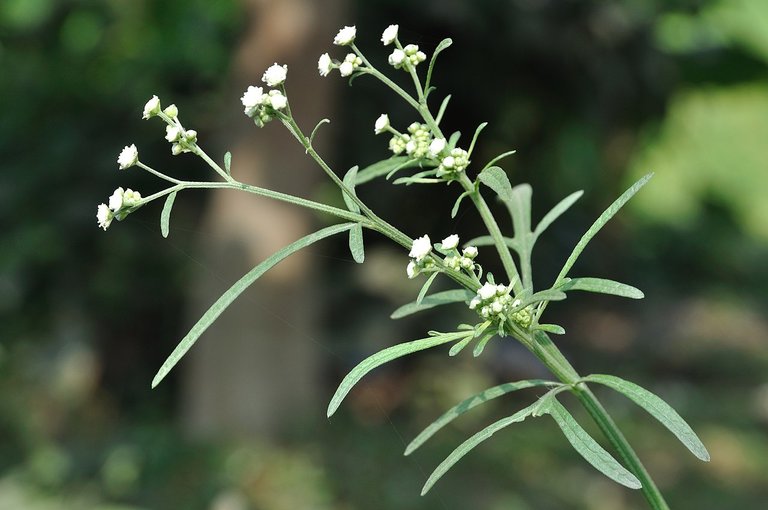Parthenium Weed | A Silent Intruder in Our Environment
Hello readers,
Our vast and beautiful natural world is filled with millions of different flora and fauna and though we may think that all plants and animals are good for us, that's not always the case. Because this planet is not only covered by all good plants but there exists some seemingly harmless plants which silently pose a significant threat to our environment and our personal health. In today’s post, I will be talking about one such plant which is named Parthenium weed. So if you are interested, let’s learn about this plant and how it harms ecosystems and human well-being and also the ins and outs of this invasive plant species and understand why it deserves our attention.
What is Parthenium Weed?
Parthenium weed, scientifically known as Parthenium hysterophorus, is a plant native to the USA but over a long time span, it has spread its roots across the globe nowadays. It is also called by the names Congress plant or Carrot Grass and with its small white flowers and feathery leaves, this bush type plant easily gets blended into the surroundings, but don't let its appearance fool you, because Parthenium weed has a habit of thriving in disturbed habitats like roadsides, fields and wastelands where it can quickly grow and multiply and establish itself and outcompete native plants.
Harmful Effects
The evil nature of Parthenium weed lies in its ability to rapidly spread and reproduce, crowding out other plants and reducing biodiversity. They act like an alien invasion of the native nature and their harmful allopathic chemicals inhibit the growth of all the neighboring vegetation which further solidifies its dominance in the ecosystem. But wait as the harm doesn't just stop there. The pollen of the Parthenium weed can trigger severe types of allergic reactions in humans and animals thus causing respiratory issues and skin irritation. Direct contact with the plant can lead to discomfort and health problems, making it uncomfortable for anyone who crosses its path.
Spread and Control
Parthenium weed can be labeled as a master of disguise because it can spread very quickly through contaminated goods or can spread through wind and water. Once introduced to a new area, it can take hold by quickly growing and reproducing and thus overtaking the whole plain in a matter of months. Controlling Parthenium weed requires a concerted and continuous effort involving mechanical removal, chemical herbicides and promoting the growth of native plants to outcompete the invader. I personally have taken part multiple Times in my school days to remove them mechanically and still do it whenever I see them growing near my house or roadside. I believe Awareness and vigilance are the main keys here to prevent its massive spread and thus mitigate its negative impacts on the environment and human health.

How did it come to India?
Parthenium is a native plant of America and my country was free from it even a hundred years ago. But one interesting event changed it during the great famine in our Country when wheat was sent to India from the USA through the PL 480 (food for peace) program that no doubt helped us to overcome the situation in the past. However, unfortunately this batch of wheat was carrying an unexpected passenger, the seeds of the parthenium weed. As a result, when this shipment arrived in India, it unintentionally introduced the dangerous weed to our soil and from there, the seeds of parthenium took root and began to spread like wildfire as it found hospitable environments in various regions of our country. Despite different types of efforts to control its spread, the highly resilient nature of parthenium allowed it to establish itself firmly and started causing widespread ecological and health issues.
Furthermore, the incident highlights the importance of proper quality control measures while performing international trade to prevent the introduction of invasive species to new places. If both nations had proper checks in place back then, the contamination of the wheat with parthenium seeds could have been detected and avoided before it reached the Indian shores. But anyway, we should learn from past mistakes and start implementing robust protocols, so that we can safeguard our ecosystems and agricultural systems from the harmful effects of invasive species like parthenium weed.
Conclusion
Last but not least, In our vast natural world, I believe every plant plays an important role, but some like Parthenium weed always try to disrupt the natural balance of ecosystems and start threatening our well-being. By properly understanding the characteristics of these types of invasive specimens and taking proactive measures accordingly to control their spread, we can protect our environment and ensure a healthier future for the next generations to come. Let us be more aware and join hands in the fight against Parthenium weed and other similar types of invasive and harmful plants to protect our landscapes and preserve the beauty of nature.
I hope you like reading my post. Let me know your thoughts in the comment section below and I will be seeing you all in my next post.
Join Inleo calendar prompt initiative and start writing posts!
Join Inleo platform for free!
Posted Using InLeo Alpha

I have also seen this plant in my country Nigeria and I never knew it's native to the US. You're very correct about its growth rate, it grows very fast and competes with indigenous plant